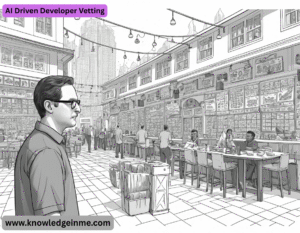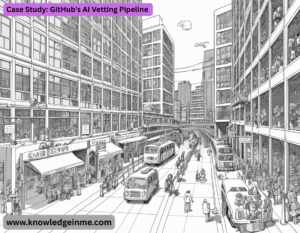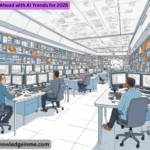AI Driven Developer Vetting AI-driven developer vetting uses machine learning algorithms and artificial intelligence to assess technical skills, coding abilities, and problem-solving competencies of software developers. This approach automates and enhances traditional technical evaluation processes.
Key Benefits
- Efficiency: Reduces screening time from hours to minutes
- Objectivity: Minimizes human bias in initial assessments
- Scalability: Can evaluate hundreds of candidates simultaneously
- Depth of Analysis: Goes beyond code correctness to assess style, patterns, and best practices
Common AI Vetting Approaches
- Automated Coding Challenges: AI evaluates solutions for correctness, efficiency, and elegance
- Code Portfolio Analysis: ML algorithms assess GitHub/GitLab repositories for qu/ality metrics
- Behavioral Pattern Recognition: Natural language processing evaluates communication skills
- Technical Interview Analysis: AI assesses video interviews for technical content
Leading AI Vetting Platforms
- HackerRank (AI-powered code evaluation)
- Codility (automated code assessment)
- Coderbyte (AI-driven challenges)
- DevSkiller (real-work simulation scoring)
- Qualified.io (full-stack project evaluation)
Implementation Considerations
- Customization: Tailor assessments to your tech stack and requirements
- Human Oversight: Combine AI with human review for final decisions
- Candidate Experience: Ensure transparent communication about the AI evaluation process
Core Components of AI-Driven Developer Vetting
A. Automated Technical Assessments
- Coding Challenges: AI evaluates code for correctness, efficiency, readability, and scalability.
- Example: HackerRank’s AI checks for optimal algorithms and edge-case handling.
- Real-World Simulations: Platforms like DevSkiller mimic actual work tasks (e.g., bug fixes, feature implementations).
- Pair Programming Bots: AI bots (e.g., CoderPad’s interviewer assistant) simulate live coding sessions.
B. Code Repository Analysis
- GitHub/GitLab/Bitbucket Scanning: AI tools (e.g., Sourcery, CodeClimate) assess:
- Code quality (DRY, SOLID principles)
- Commit history (frequency, collaboration patterns)
- Open-source contributions
- Plagiarism Detection: AI flags copied or boilerplate code (e.g., Codility’s similarity checker).
C. Behavioral & Cognitive Assessments
- Natural Language Processing (NLP):
- Evaluates written responses (e.g., documentation, technical explanations).
- Assesses communication skills in chat-based interviews (e.g., Metaview’s AI analysis).
- Problem-Solving Patterns: AI detects how candidates approach debugging or system design.
D. AI-Powered Technical Interviews
- Automated Video Analysis: Tools like HireVue analyze:
- Technical explanations (speech-to-text + NLP for keyword accuracy).
- Problem-solving logic (structured vs. ad-hoc approaches).
- Whiteboard Coding Assistants: AI suggests optimizations in real-time (e.g., Mimir’s interview platform).
Challenges & Ethical Considerations
A. Potential Biases in AI Models
- Training data may favor certain demographics or coding styles.
- Solution: Regular bias audits (e.g., IBM’s Fairness 360 toolkit).
B. Over-Optimization for Tests
- Candidates may “game” AI systems (memorizing patterns instead of real skills).
C. Lack of Human Nuance
- AI may miss unconventional but valid solutions.
- Solution: Hybrid approach (AI filters + human review for top candidates).
D. Privacy Concerns
- Scanning personal GitHub repos may raise data privacy issues.
- Solution: Explicit candidate consent & anonymized evaluations.
Future Trends in AI Vetting
- Personalized Learning-Based Assessments
- AI adapts test difficulty based on candidate performance (like a technical “CAT exam”).
AI-Generated Coding Tasks
- Tools like ChatGPT can auto-generate company-specific challenges.
- Predictive Analytics for Hiring Success
- AI correlates assessment results with long-term job performance.
VR/AR Coding Environments
- Meta’s Code Labs and similar tools simulate real-world dev environments.
- Blockchain for Credential Verification
- AI + blockchain ensures authentic certifications (e.g., Ethereum-based skill tokens).
Best Practices for Implementation
- Combine AI with human judgment (e.g., AI shortlists, humans finalize).
- Ensure transparency—candidates should understand scoring criteria.
- Regularly update AI models to reflect new tech stacks (e.g., AI trained on Rust if needed).
- Prioritize candidate experience—avoid overly rigid AI rejections.
Advanced AI Vetting Techniques
A. Deep Code Analysis
- Static Code Analysis: AI examines code structure without execution (e.g., SonarQube + ML for detecting anti-patterns)
- Dynamic Code Analysis: AI runs code with test cases and evaluates runtime behavior (memory leaks, performance)
- Meta-Learning for Skill Inference: AI predicts expertise in unseen technologies based on known skills (e.g., a React dev’s potential Vue.js proficiency)
B. Multidimensional Scoring Systems
- Modern platforms use composite scoring across:
- Technical Accuracy (50%)
- Code Efficiency (20%)
- Readability & Style (15%)
- Originality (10%)
- Speed (5%)
- Example: TripleByte’s adaptive scoring matrix
C. Context-Aware Evaluation
- Project-Based Assessment: AI evaluates entire projects (e.g., setting up CI/CD pipelines)
- Environment Simulation: Tools like Coder simulate cloud IDE environments with AI proctoring
- Collaboration Analysis: AI assesses pair programming sessions using Git history metadata
Implementation Roadmap
Phase 1: Assessment Design
- Define competency matrix (language, frameworks, soft skills)
- Select appropriate AI tools (coding tests vs. project evaluation)
- Calibrate difficulty levels (junior vs. senior thresholds)
Phase 3: Continuous Improvement
- Feedback loops with hiring managers
- A/B testing different evaluation models
- Periodic model retraining with new hire performance data
Emerging Innovations
A. Neurocoding Assessments
- EEG headsets measuring cognitive load during coding (experimental)
- Eye-tracking for code reading patterns analysis
B. AI-Generated Developer Profiles
- Automated skill graphs showing strengths/weaknesses
- Predictive growth trajectories (e.g., “This candidate will likely master Go within 6 months”)
C. Blockchain-Verified Credentials
- Smart contracts for immutable skill certification
- Decentralized reputation systems (GitCoin-style skill tokens)
Case Study: GitHub’s AI Vetting Pipeline
Process:
- AI scans 100+ code metrics across public repos
- ML model predicts “hireability score” (82% accuracy)
- Human reviewers get AI-generated talking points
Results:
- 40% reduction in time-to-hire
- 28% improvement in 6-month retention
- 15% increase in team diversity
Ethical Framework for AI Vetting
- Explainability: Candidates can request assessment breakdowns
- Appeal Process: Human override for AI rejections
- Bias Testing: Quarterly fairness audits
- Data Privacy: GDPR-compliant data handling
Future Outlook (2025-2030)
- AI “Turing Tests” for Developers: Can candidates distinguish AI reviewers from humans?
- Automated Team Fit Analysis: AI predicts how candidates will mesh with existing teams
- Lifelong Learning Profiles: Continuous AI assessment throughout careers
Hyper-Personalized Assessment Engines
A. Adaptive Testing 2.0
- Neural Psychometrics: AI models that adjust test difficulty in real-time based on cognitive response patterns
- Contextual Problem Generation: Creates company-specific scenarios (e.g., “Optimize our actual production API endpoint”)
- Skill Gap Mapping: Visualizations showing exact competency deficiencies and recommended learning paths
B. Behavioral DNA Profiling
- Micro-expression Analysis: AI detects problem-solving frustration points during video interviews
- Keystroke Dynamics: Measures coding flow state through:
Backspace frequency
- Code-completion usage patterns
- Debugging approach timelines
Revolutionary Assessment Formats
A. Chaos Engineering Interviews
- AI intentionally breaks candidates’ running systems
- Evaluates debugging under pressure
Measures:
- Triage prioritization
- Communication during incidents
- Root cause analysis speed
B. AI Pair Programming Tournaments
- Candidates compete against GPT-4 coders
Scoring based on:
- Innovation beyond AI suggestions
- Collaborative adaptation
- Knowledge transfer effectiveness
C. Metaverse Whiteboarding
- VR environments with:
- 3D system architecture modeling
- Real-time AI design critique
- Multi-candidate collaboration spaces
Cutting-Edge Research Frontiers
A. Cognitive Load Quantification
- Using pupil dilation tracking during coding
- ML models correlating stress patterns with performance
B. Code Style Fingerprinting
- Identifying developers through:
- Variable naming conventions
- Commenting patterns
- Indentation preferences
C. Ethical Hackability Index
- AI predicts security mindset by analyzing:
- Defensive coding habits
- Attack surface awareness
- Privacy-by-design implementation






